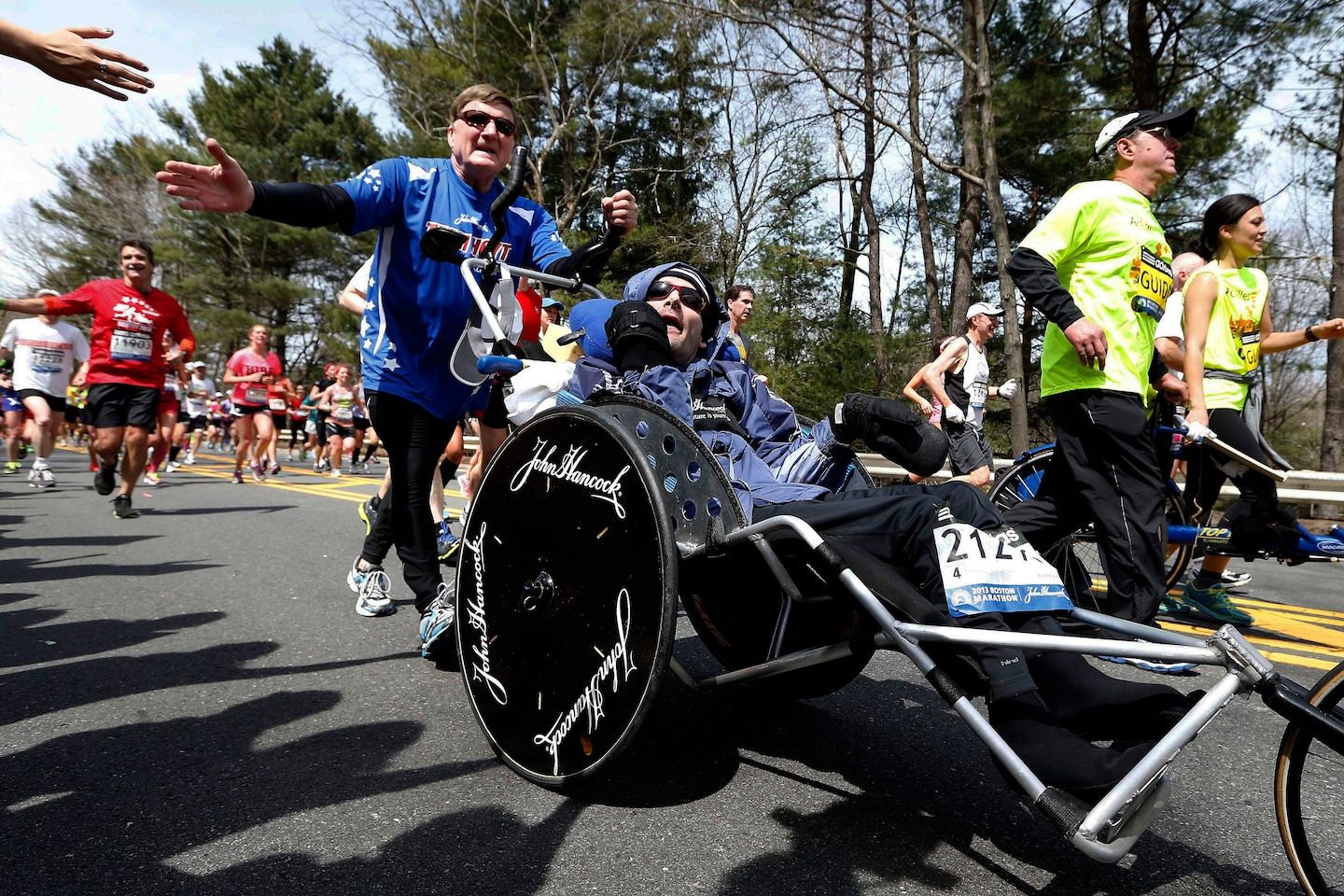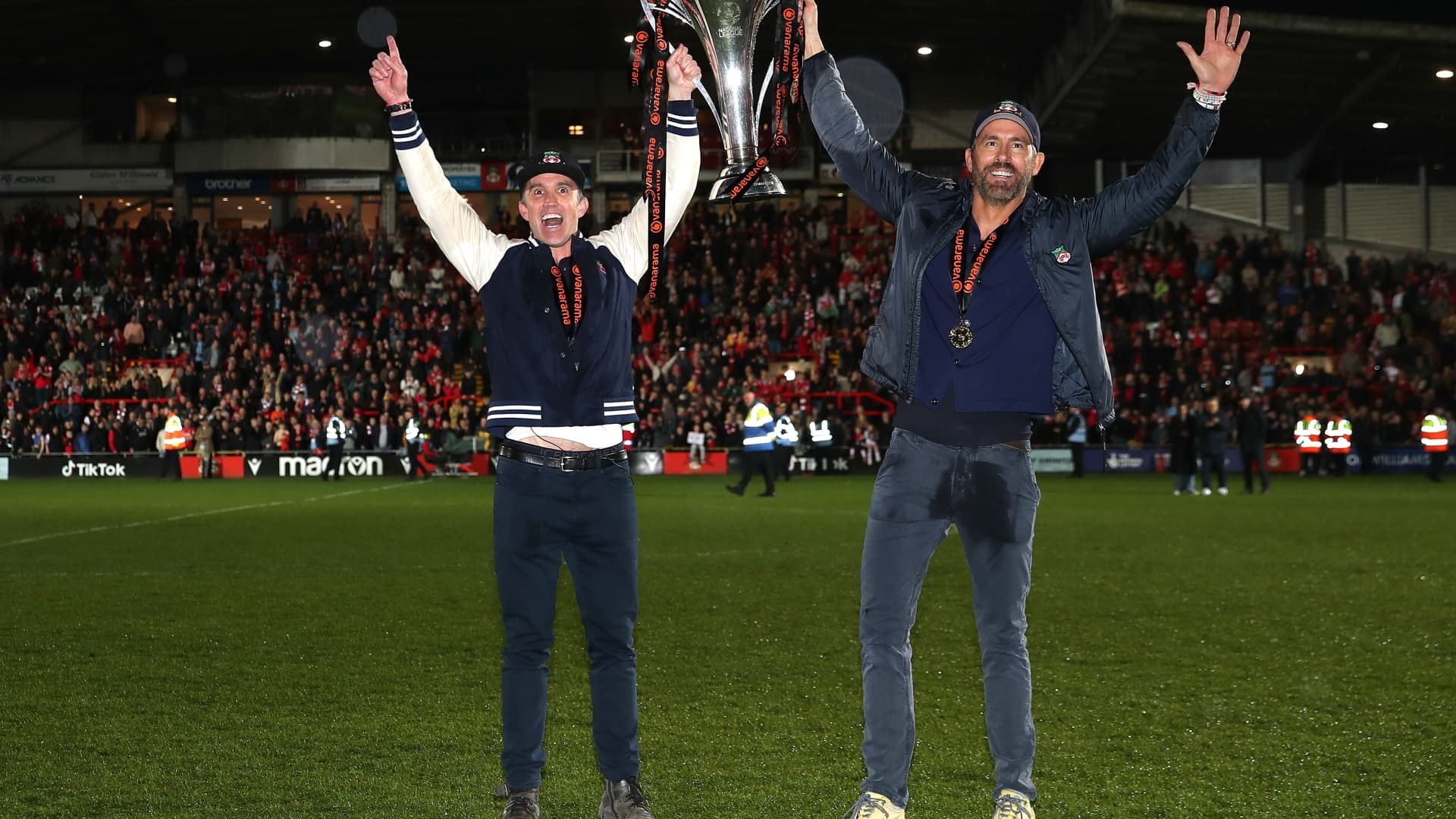Rick Hoyt, who rolled his way to marathon fame, dies at 61
Listen 7 min Gift Article Share
As Boston Marathon runners gathered on an April morning in 1980 in Hopkinton, Mass., a young man in a modified wheelchair was pushed by his father into the back-of-the-pack group without numbers. The pair had no idea if they would be stopped by race officials or even if the wheelchair would hold up over the 26.2 miles to Copley Square.
About three hours and 11 minutes later, Rick Hoyt and his father were moving down Boylston Street toward the finish line.
Over nearly four decades, Mr. Hoyt and his father, Dick Hoyt, became celebrated fixtures of the Boston Marathon — with a bronze statue of the duo known Team Hoyt dedicated in 2013 near the marathon’s starting point where they first set off in 1980.
They went on to compete in more than 1,100 other athletic events, including more than 70 marathons and 250 run-bike races and triathlons. In 1992, they left Santa Monica Pier in California for a 45-day trek across the United States to raise money for charities and research into cerebral palsy, which had left Rick Hoyt a quadriplegic and unable to speak.
Advertisement
Rick Hoyt, who died at 61 on May 22 at a health-care center in Rochdale, Mass., communicated through a keypad controlled by head movements. He was once asked how he felt when he rolled across the Boston Marathon finish line. Mr. Hoyt wrote: “Bill Rodgers,” a marathon star of the 1970s.
A family statement said Mr. Hoyt died of respiratory complications. His father died of heart-related problems in 2021.
Through a mix of endurance and resilience — including at least one near-drowning of Rick Hoyt during a swimming event — the father-son team became leading figures in helping shift attitudes on opening sports to people with disabilities. “That first race,” Dick Hoyt told South Coast Today in 2011, “nobody would come near us. Nobody would talk to us. But we just went ahead and did it, and now we’re up to 1,042 races.”
Advertisement
In their last Boston Marathon together in 2014, they were race royalty. They were stopped along the course for photos and to interact with spectators in wheelchairs. In 2020, the Hoyts became the first “push-assist team” inducted into the USA Triathlon Hall of Fame.
“No matter how fast I run,” Dick Hoyt once told the Chicago Tribune about competing with his son, “he always beats me to the finish by a second.”
‘Special bond’
Richard Eugene Hoyt Jr. was born in Winchester, Mass., on Jan. 10, 1962. His umbilical cord wrapped around his neck during childbirth, cutting the supply of oxygen to his brain and leaving him severely impaired. His parents refused suggestions to have him institutionalized and improvised an education system at home.
His mother, Judith, used objects such as wood blocks and fur to illustrate the difference between hard and soft; the alphabet was cut from sandpaper, and Mr. Hoyt’s finger was moved the along the letters to familiarize him with their shapes. In the early 1970s, he began using a specialized computer, nicknamed the Hope Machine, designed by an engineer from Tufts University. His first message: “Go Bruins.”
Advertisement
His mother successfully pressed the local school district to accept Mr. Hoyt as a student, setting a precedent used across the country to open public education to pupils with special needs.
“Being a nonvocal person doesn’t make me less of a human being,” Mr. Hoyt wrote in a message during an interview with the Runner magazine in 1986. “I have the same feelings as anyone else. I feel sadness, joy, hunger, love, compassion, pain.”
In 1977, a five-mile race was held in Westfield, Mass., to benefit a high school classmate who had been paralyzed in an accident. Mr. Hoyt asked his father if they could join. His father, then an officer with the Air National Guard, felt he was in good enough shape to go the distance. All Mr. Hoyt had was an ordinary wheelchair.
The chair was hard to keep straight. Mr. Hoyt’s father said it began veering off toward the woods. They came in second to last. Rick Hoyt loved every minute.
Advertisement
“When my dad and I are out there on a run, a special bond forms between us,” Mr. Hoyt told the New York Times in 2009.
They decided to aim for the Boston Marathon, which in those days permitted so-called “bandits” to run without numbers or registration. First, however, they needed to find a better racing chair. They tried a number of innovations, including one iteration with wheels like a shopping cart.
Eventually, they adapted a low-slung three-wheeled design used by many wheelchair athletes. For training when Mr. Hoyt could not make it outside, his father dropped a 100-pound sack of concrete mix into the racing chair and set off on a run.
Their best marathon time was 2:40:47 at the 1992 Marine Corps Marathon in Washington, according to the Hoyt Foundation website. “When I start pushing Ricky, I get this feeling,” Dick Hoyt told the Runner. “I go all out. I get up more for Rick. I want to pass people. I want to beat them. When I get behind that chair, it helps me.”
Advertisement
Other races required more innovations. For run-bike events, they developed a cycle that cradled Rick Hoyt in front. An earlier idea of a trailer-style rig ended when Rick Hoyt went tumbling over during a triathlon. “What am I trying to do, kill this kid?” Dick Hoyt recalled telling himself.
For triathlons and other events with swimming, Mr. Hoyt’s father at first tried to hold him while he did a sidestroke. That almost ended in tragedy at an event in the mid-1980s during a half-mile swim. Mr. Hoyt went into spasms and was caught in the ropes on one of the buoys, his father recounted. After that, they developed an inflatable raft that carried Mr. Hoyt as his father towed it while swimming.
In Canada for their first full Ironman — a 2.4-mile swim, 112 miles of biking and a marathon-distance run — Mr. Hoyt’s father cramped up during the swim but waved off medical teams calling for him to quit. They came across the finish line at 1:30 a.m., 17 hours and 53 minutes after they started.
Advertisement
Isn’t that the finest sight you’ll ever see?” said the announcer. (Their best Ironman time was 13:43:37 in Germany in July 2000.)
“I was running for Rick, who longed to be an athlete but had no way to pursue his passion,” Mr. Hoyt’s father wrote in his 2010 book, “Devoted: The Story of a Father’s Love for His Son,” written with co-author Don Yaeger. “I wasn’t running for my own pleasure. I was simply loaning my arms and legs to my son.”
In the book, Rick Hoyt described his dreams if he were ever able to leave his wheelchair. High on the list, he wrote to his father: “I would push you in the Boston Marathon.”
Rick Hoyt received a bachelor’s degree in special education from Boston University in 1993. He worked at Boston Children’s Hospital to help develop communication programs for patients unable to speak. He addressed audiences using a voice-generating computer.
Advertisement
The 2013 Boston Marathon was planned as their last together. They were near the 25-mile mark when pressure-cooker bombs exploded in a terrorist attack near the finish line, killing three people and leaving hundreds injured. Team Hoyt rescheduled 2014 as their final father-son traverse of the Boston course.
From 2015 through 2017, Mr. Hoyt was pushed in the Boston Marathon by Bryan Lyons, a family friend who died in 2020.
Mr. Hoyt’s mother, the former Judith Leighton, died in 2010. Survivors include two brothers. Mr. Hoyt said he retired from competitive races after his father’s death.
“I make runners aware that a disabled person can still participate in events,” Mr. Hoyt once wrote in a message to a journalist. “It makes me feel not disabled.”
GiftOutline Gift Article
Source: The Washington Post


